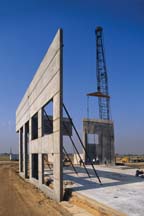
Adhesive and sealant companies are engaged in a balancing act. On the one hand, shrinking profit margins are forcing companies to cut costs and streamline their processes. On the other hand, companies need to constantly innovate - delivering new products and product enhancements to meet customer and regulatory demands.
Dryvit Systems addressed this challenge by consolidating processes and sharing information throughout the product development process with Formation Systems' Optiva.

Improving the Product Development Process
Dryvit develops and manufactures Exterior Insulation Finishing Systems (EIFS), building materials, and related products, and markets them to industrial, commercial, institutional, and residential markets.The company's strategy was to eliminate redundant product development efforts by sharing information among all stakeholders and to optimize the allocation of resources by providing management with real-time visibility into the R&D process. This appeared to be a formidable challenge; Dryvit managed more than 800,000 formulas across multiple development sites in the United States, Canada and Europe.
Gary Rezendes, IT manager, Dryvit Systems, says Dryvit knew it needed a strong and scalable system to globally manage its entire product development process.
"We wanted the ability to maximize the performance of our product development resources with state-of-the-art information technology," he says. "Simply put, we wanted a solution that supported lower cost, better products."
In addition, the solution needed to leverage Dryvit's investment in an ERP system. The company's existing system did not integrate with its new ERP system. Moving product data from R&D to production required extensive manual re-entry of formulas. The result was a slow, error-prone process that was hurting Dryvit's ability to realize the full value of its ERP investment. A solution was needed that would both improve R&D processes and integrate tightly with its ERP system.
While the challenge it faced was by no means unique, selecting a product development solution that met Dryvit's needs was no easy task.
A Global Solution
Dryvit evaluated a number of solutions before ultimately selecting Formation Systems' Optiva as the nerve center of its product development process. With Optiva, Dryvit chose a product development solution that enabled it to meet its objectives:- Global product development collaboration within and between five geographically dispersed operations.
- Scalability to manage 800,000 formulas today and grow with future needs.
- Real-time management visibility across the entire product portfolio, including accurate and detailed pricing of all current and in-process products.
- Tight integration with its ERP system.
"We had a lot of confidence in Optiva and saw that it could help us solve our product development bottleneck," Rezendes said. And with Formation Systems, Dryvit gained a partner that had a proven track record of helping companies become more profitable by improving their ability to innovate.
Formation Systems and Optiva enabled Dryvit to overcome what looked like a daunting challenge and achieve a quick positive return on investment. Optiva has even enabled the company to provide better service to its customers.
After just a three-month implementation process, Dryvit began saving significant time and money in the creation of new products simply by reducing manual entry and formula redundancies across its North American offices. An example is how Dryvit applies new colors to existing formulas. Before Optiva, rolling out a new color formula required the manual creation of each Bill of Material across as many as 40 base formulas. Now, Dryvit can automatically generate Bills of Material for entire families of products based upon the approval of a single tint formula.
Optiva's benefits extend beyond the R&D department. Recently, Dryvit went live with an online order-management system that enables customers to submit orders directly on the company's website. Once an order is entered, automatic checks are run against the Optiva formula database. If the specified product exists, the order is automatically generated in Dryvit's ERP system. If the product does not exist, Optiva uses the specifications of the customer to automatically generate a formula request and forwards it to the color lab for development. Customers can even access real-time status reports on their orders in development by way of the online order management system and Optiva.
Building Sustainable Competitive Advantage
Staying competitive today requires bringing innovative products to market while cutting costs and improving service. Dryvit's implementation of an enterprise-wide product development system has helped the company cut costs, streamline processes and make R&D more productive."Now we can focus our creative powers on better products rather than better processes," says Rezendes. "Our R&D department has become a sustainable competitive advantage, offering Dryvit product differentiation and business growth."
For more information, visit http://www.formationsystems.com .
What to Look for
Following are some features and functionalities that adhesives and sealants companies should look for in a product development system.- Powerful search and compare features to help leverage past learnings.
- Streamlined and automated approval processes to speed time-to-market.
- Real-time visibility into global requirements and regulations to minimize last minute rework and delays.
- Real-time visibility into project status and risk to focus resources where needed.
- Tools to optimize formulations to desired specifications, reducing the need for trial and error.
- Version control and audit trails that maintain a living history of formula changes.
- Automated guidelines and restrictions to communicate up-to-date requirements.
- Material rationalization tools that use critical-to-quality characteristics and what-if scenarios to enable cost savings.
